Greenhab Report – February 1st
Crew 188 Sol 4 Green Hab Report 01February2018
Renee Garifi, Executive Officer, Guest writing for Julia De Marines (Crew Astronomer/GreenHab Officer) 01 February 2018
Environmental control: Heating
Ambient with door opening: Shade cloth on
Working hours in Green Hab: 09:00-09:30, 11:00 – 14:00, 18:00 – 19:00 Outside temp at working hour: 10ºC
Inside temp at working hour: 25ºC
Inside temp H: 35ºC
Inside temp L: 19ºC
Inside humidity: 47 %
Inside humidity H: 90%
Inside humidity L: 16%
Hours of supplemental light: 05:00 – 11:59
Changes to the crops: Rearranged and continued trimming back cucumber, tomato, and bean vines and stems. No harvesting today, will harvest tomorrow. Daily water usage for crops: 10 gallons
Time(s) of watering plants: 11:00 – 14:00 (5 gallons), 18:00 – 19:00 (5 gallons)
Changes to research plants: After an email from Atila, we will be monitoring the quinoa for sprouting.
Narrative: Julia showed Zac and I which plants to trim and move. We spent time working on the NASA VEGGIE OASYS plant growth prototype hardware which we have relocated to the west corner shelf of the GreenHab. We took photographs for the scientists at Kennedy Space Center. The final fill amounts for the reservoir chamber in the unit was 2200 mL of water and each seed pillow was filled with 100 mL of water to start. We will be growing Italian Basil and Salad Bar Lettuce. We were excited to share our progress with Julia when she returned from her EVA trek!
We spent some time trimming back the dead leaves on the plants on the west shelves and propping up some of the drooping tomato plants. I believe there is a plan to obtain more tomato cages which is needed for the high volume of tomato plants being grown.
Lastly, we moved the existing sun shade a little lower down to provide the plants in the middle and east sides of the GreenHab more relief from the direct sunlight.
Future needs and questions: Is there a plan for ordering an additional sun shade? We also need additional tomato cages. We received the gardening gloves. Thank you!!!
Crew Photos – February 1st
Creative Report – February 1st
MDRS Crew 188 Creative Report 01FEB2018
Homo Ludens: Training for a Martian Olympiad.
Author’s name: Dr. Sarah Jane Pell @Aquabatics
As the MDRS Crew 188 artist-in-residence, I actively champion the support and integration of working tolerances for play and performance within mission architectures and EVA simulations. In preparing for this mission, I initiated a challenge to the ISU Crew 188 for the training and preparation for a Martian Olympiad event at MDRS to coincide with the Opening Ceremony of the Winter Olympics on 09 Feb 2018. Prior research shows that play and performance is beneficial for individual physical and psycho-spiritual health and crew wellbeing on Earth. Future crews on Mars will be no exception.
Today MDRS Crew 188 – EVA 4 with Julia De Marinares, Dr. Ryan Kobrick, and I (Dr. Sarah Jane Pell) designed a series of tasks specifically for the purpose of encouraging exertion and teamwork [See EVA and Journalist report]. We discussed the parallels between training for an Olympic event, and training for a Mars Mission. During the pre-flight phase, Astronaut candidates undertake training for the acquisition and development of prerequisite physiological, psychological, psycho-spatial and human-factor benchmarks to perform in space, and manage pre-flight expectations. During pre-performance phases, Athletes undertake a parallel journey in the lead-up to a world-class performance event like the Olympiad. Pre-flight is a time for the rehearsal of the time-tagged performance maneuvers, learning NomOp, and balancing expectations. Astronauts also learn from the questions arising about the temporal proximity required for relating live action and collective action between positions, locations and communication networks, real and illusory, in the altered gravity environment of space. For example, practical Extra-Vehicular Activity (EVA) or spacewalk training prepares the candidates for new space/spatiality. Today, our EVA prepared for the marathon tasks of a long-walk with equipment, a mountain summit and safe decent, another long walk, and a ball game testing coordination, concentration and response-time after our exertion. The exercise was physically demanding as we anticipated, but our team-work, problem-solving, cooperation rather than competition, outlook and sense of adventure and fun, made it the best day out on the surface of Mars yet!
Here are my plans for experimenting with the Insta360 Pro over the MDRS Crew 188 mission:
(a) 31-JAN2018
Total Lunar Eclipse 360 Video 8K Panorama
(d) 03-FEB2018 (f) 05-FEB2018
Extra Vehicular Activity [EVA] Rover/ATVs – Maintaining Batteries 360 Video 4K
(b) 01-FEB2018 (e) 04-FEB2018 (g) 06-FEB2018
Spacesuit Glove Validation 360 Video 6K 3D
(c) 02-FEB2018
Green Lab, Hydroponics 8K Photo 3D Time-Lapse
(h) 07-FEB2018
Mars Desert Research Station 360 Photo 4/6/8K 3D/Pano
(b) 01-FEB2018 (j) 09-FEB2018
Martian Olympiad – training & opening ceremony 360 Video 6/8K 3D/Pano
(a) 02-FEB2018 (i) 08-FEB2018
Performing Astronautics – experimentation 360 Video 6/8K 3D/Pano
We respect that forms of play and performance in space differ from Earth-based activities due to the unique aspects of human-space physiology, perception and environment. Back at the MDRS Habitat, conversations continued with Engineer Zac Trolley about the challenge of sharing that kind of experience in the moment of discovery with an audience or end user so encourage them to want to take up the spirit of exploration, like a mantle, and to conceive of a life beyond Earth. We discussed how returning Astronauts go through a process of Space-Earth Adaptation. The encumbrances of returning to Earth including sources of stress such as gravity, motion, obstacles to and facilitators of adequate coping, changes in social interaction, the role of temporal factors relating to mission objectives quickly fade. After experience-rich engagements in space, post-flight Astronauts fill autobiographical accounts with a lingering sense of adventure and accomplishment, enjoyment and fulfillment. But in the many-to-many information-filled world, we had to find a new form, and a new story, to transform the lives of those who may not yet have the spark and fervor for space exploration. We talked about the inspiring works of game-developer and Astronaut Richard Garriott and his investment in SpaceVR. We are now exploring the potential for our Crew to play a role in developing a VR product.
Trolley reminds me that nothing we do here at MDRS is in isolation. Everything plays a role in the advanced life-support system sustaining us: even outreach activities, as simple as a game of catch, and a recorded conversation on the couch. My creative research today follows on from my prior collaboration with Prof. Florian Mueller of the RMIT Exertion Games Lab, however here I am specifically interested in how the applied results from these encounters may inform the design of terrestrial space adaptation strategies to address a range of conditions of spaceflight, and space habitability. Additionally, the 8K 3D 360 capture of our Mars Olympiad activities with the Insta360 Pro will be developed in collaboration with A/Prof. David Barns, Director of the Monash Immersive Visualization Platform, and it may lead to a VR experience. What we are looking for now, is the classic story arc, that helps us frame the experience for broader audiences, and helps to inspire our generation to reach Mars. That is why we are here. [end]
Sol Summary – February 1st
Crew 188 Sol 4 Summary Report 1FEB2018
Sol 4
Summary Title: A sol featuring soul with the devastation of soles Author’s name: Ryan L. Kobrick, Ph.D., MDRS Crew 188 Commander Mission Status: All nominal
Sol Activity Summary:
Let’s jump to the bottom line. My hiking boots were completely destroyed on our hike to Phobos Peak with the soles peeling off the bottom. An EVA with modest to difficult objectives was challenged with equipment failures and ingenuity to solve problems as they occurred. This is the type of exploration we need for a Mars mission. Calculating risks, making decisions, and with collective exploration experience solving problems. There’s going to be a lot of problems. The EVA Macgyver of the day was Sarah Jane, fixing one boot with a safety whistle, and the other with my laces and some zip ties I was using. Between Julia, SJ and I we were challenged physically and mentally. I had suggested Phobos Peak for the EVA, and I was clearly willing to lose my boots over it. Luckily my hiking shoes are rugged and ready to step up to the next EVA challenge.
The crew enjoyed the scenic views from the science dome during a session of Kung Fu Thai Chi in the morning. Every morning needs to start off on the right foot… even if part of your foot falls off later. The crew also cracked into Cottage Cheese with Blackcurrant Puree space desert from the Russian Space Food Laboratory. It’s apparently “approved by space”. Further work continued on the NASA VEGGIE OASYS project in the Green Hab. We also finally opened the dust load experiment that I am running from NASA Glenn Research Center. I’m excited to set up the hardware and see how much dust we are tracking into the hab. It’s a dusty environment, and knowing how dirty it gets during key activities (EVA airlock, post EVA clean up, and more) we can help prepare future life support systems with the correct type of filters.
Spacesuit Up!
Ryan L. Kobrick, Ph.D.
MDRS Crew 188 Commander
Look Ahead Plan:
EVA 5 is planned for tomorrow to revisit a site from EVA 2 and to further add navigation and waypoint data for the crew to use on all EVAs. Meanwhile several other projects will be underway inside the dome.
Anomalies in work:
MDRS Director is coordinating power system updates with contractors. There was a site visit today.
Robotic observatory currently not functional. MDRS Astronomy lead working problem.
Weather:
The weather was clear until mid-day when clouds rolled into the area.
Crew Physical Status:
It was a busy day all around, so we are looking at our mission ahead to plan out key EVAs, science projects, and fun activities to make sure we are having a well-balanced experience.
EVA:
One is on the books for tomorrow.
Reports to file:
1. EVA #5 requests
2. Ops Report
3. Sol Summary
4. Journalist Report
5. Creative Report
6. Green Hab Report
7. Daily Photos
Support Requested:
Website updates.
Microwave timer works, but main chamber is not functioning/heating. [end]
EVA Report – February 1st
Crew 188 EVA #4 Summary Report 1FEB2018
Author’s name: Ryan L. Kobrick, Ph.D., MDRS Crew 188 Commander
Purpose of EVA: To test human endurance on a pedestrian EVA to Phobos Peak and test the 360 video capture in the field.
Location of EVA: Phobos Peak Rock
UDM27 Coordinates: 519260 E, 4250260 N
Number of EVA Crew: 3
Participants: Julia DeMarines (EVA CDR), Sarah Jane Pell, and Ryan Kobrick EVA Commander: Julia DeMarines Rovers used: none
Duration: 4 hours 14 minutes
EVA Departure Time: 10:44am
EVA Return Time: 14:12pm
Summary:
The EVA had three primary objectives that were all completed today by the crew:
1 – sample potential “green” samples for Julia’s chlorophyll detection project with NASA Ames
2 – shoot Insta-360 Pro high definition footage for Sarah Jane’s Monash Immersive Visualization Platform project
3 – summit Phobos peak while collecting biometric data for Ryan’s EVA metrics study funded by Florida Space Research Program
The crew faced equipment challenges (see Sol 4 Summary Report) but was able to overcome and persevere to meet the mission goals. The investigators have high hopes for the data collected, but regardless experienced a true Martian adventure.
The crew walked to Phobos Peak with two stops to set up the 360 camera, one stop for sampling, and several stops for interesting formations. We summitted the mountain by scrambling up the West face (the side you can see form the Hab) with several safety stops to combat fogging and shoe repair issues. The international trio waved their 3 flags from the summit for a mini photoshoot from the Hab. On the walk back from the successful mission, the crew stopped for a rare opportunity to toss around a bouncy ball on Mars testing their reflexes, spacesuit glove dexterity and coordination. A radio was dropped near the end of the EVA, but using the GPS track the crew quickly recovered the valuable asset. [end]
Operations Report – February 1st
Crew 188 Operational Report 01/02/2018
Sol 4
Zac Trolley
Non-Nominal Systems: Propane supply, Microwave, Rover Charging infrastructure, Greenhab temperature sensor. Notes on non-nominal systems: See individual systems at the end of the report. Generator (hours run): 18.8h
Solar: SOC 81%
Diesel: 78%
Propane: 62 psi
Ethanol Free Gasoline (5 Gallon containers for ATV): 8 Gallons Water (trailer): 0 Gallons
Water (static): 300 Gallons
Trailer to Static Pump used: No
Water (loft) – Static to Loft Pump used: Yes
Meter 130607.8
Toilet tank emptied: Yes
ATVs Used: None
Oil Added: None
ATV Fuel Used: None
# Hours the ATVs were Used today: 0
Notes on ATVs: none
Deimos rover used: No
Hours: Hours: 106.9h (Accurate as of two days ago, rover was not on campus during EVA to check hours.)
Beginning charge: N/A
Ending charge: N/A
Currently charging: No
Sojourner rover used: ASSIGNED TO DIRECTOR
Hours:
Beginning charge:
Ending charge:
Currently charging:
Spirit rover used: no
Hours: 17.5h
Beginning charge: N/A
Ending charge: N/A
Currently charging: No
Opportunity rover used: no
Hours: 13.5
Beginning charge: N/A
Ending charge: N/A
Currently charging: No
Curiosity rover used: No
Hours: 9.3h
Beginning charge: N/A
Ending charge: N/A
Currently charging: No
HabCar: Not used
General notes and comments: The Hab Director mentioned that the Rovers required an extension cord that is shorter than 25 feet. We estimate the cords being used now are 50 foot cables. I was able to find a 25 foot extension cable, meaning we could charge one rover at time based on the above specifications. Can we have the appropriate extension cables sent to the Hab in order to charge the Rovers?
Also, the configuration the rovers are in means that the rovers need to back out before they are used. Backing up in an EVA suit is hazardous since you can’t see behind you in a suit. Please advise if there is another configuration that allows charging with a 25 foot extension cable as well as the ability to drive forward during EVAs.
Summary of internet: Internet connectivity continues to be a problem even with the data purchased. Devices are having troubles connecting and
Summary of suits and radios: There is a bent clasp on suit #1 on the helmet collar. It was probably bent during the EVA, the system is still functional.
Summary of Hab operations: The microwave isn’t working anymore. The buttons work, the time counts down, but the microwave doesn’t actually produce waves to heat anything.
Summary of EVA operations: We are still brainstorming ways to combat the helmet fog. Without proper ventilation under the helmet ring, the facemasks rapidly fog up. It is becoming a safety issue on EVA.
Summary of GreenHab operations: The temperature gauge display has some non-functional LCD areas, a new one has been ordered.
Summary of Science Dome operations: The science dome is awaiting a portable heater as per the Hab Director. Summary of RAM operations: Not Operational.
Summary of health and safety issues: The propane detector has arrived, and there is a positive detection of combustible gas in the hab.
We calibrated the sensor outside, and moving the detector in different places in the Hab clearly shows that there are areas where there is a higher concentration of combustible gas than others. The instrument is of low quality and does not show us the ppm, so we have no way to tell what the levels are, and if they are dangerous.
The leak was found using soapy water, and the fitting was tightened by the crew. We will investigate tomorrow and hopefully the leak is fixed. Questions, concerns and requests to Mission Support: All nominal [end]
Journalist Report – February 1st
MDRS Crew 188 Journalist Report 01FEB2018
Mount Phoebus: A successful EVA by the Astronaut, Angel and MacGyver
SOL-4
Author’s name: Dr. Sarah Jane Pell
In underwater space analogues where the Astronaut trains for EVA simulations in Neutral Buoyancy, two divers support them: Angel who is responsible for the astronaut’s air-supply, and MacGyver who finds the tools and fixes everything so that the Astronaut can perform and accomplish the mission exercise objectives.
Today MDRS Crew 188 – EVA 4 with Julia De Marines (EV-4 Commander), Dr. Ryan Kobrick, and me (Dr. Sarah Jane Pell) were the embodiment of the successful Astronaut, Angel and MacGyver team. We set out to challenge ourselves and physically condition our bodies for the up-coming Martian Olympiad challenge by carrying our advanced life support systems, carrying out biometric and human factors research, creative research, biological survey and continued systems testing. We walked from the Habitat to Mount Phobeos and through incredibly diverse terrain. I carried a large pelican case containing the Insta360 Pro VR Camera system, an emergency whistle/compass/thermometer/light, and a bag containing a rubber ball and our national flags. Kobrick carried wearable cameras, a Garmin GPS, a toy car, and his body wired up with a range of wearable bio-monitoring systems. De Marines carried the first aid kit, camera, sampling bags and small tools for collecting biological material, and an Earth flag.
Heading out, De Marines found that her WalkieTalkie was only short-range, and therefore Pell and Kobrick had to maintain comms with HabCom. On route, the team found datum markers, chlorophyll specimens, and recorded 360 video of the Mars terrain, with the habitat and Mt. Phobeos. Upon the mountain ascent, Kobrick struggled with condensation and CO2 build up in his helmet. De Marines became his guide, his Angel. Half way up, Pell noticed that Kobrick had lost the sole of his boot. She “MacGyvered” the scarpa with her emergency whistle, tying the sole to his heal and ankle so that he could continue. Upon reaching the summit, his second boot sole came off. This time, Pell used shoes laces to keep it on so that he could descend. The EVA-4 Crew held their national flags aloft in the wind for photos and video taken by the HabCom crew in the Science Dome some 1mile away. After the celebrations and cool down from the wind and shade from the midday sun, Pell and De Marines led Kobrick down the descent route without incident, and the team followed the GPS directions back to collect the Insta360 Pro that had been recording the summit attempt in the midday sun. On route back to the Habitat, the crew found an enchanting small red canyon that we followed. It caused a brief disruption to communications, but it was incredibly scenic and led to some interesting sample discoveries including some ridged amber deposits. On the other side of the canyon, we found an open plain, and in our state of exhaustion and excitement, we played catch with the ball. Such a simple gesture, amplified our sense of fun and exploration. We had spent almost 3 hours in our suits and adjusted our gate, our balance, our sense of bodily extension and coordination to facilitate the augmentation of our life support systems and our apparatus: for this reason, playing with our coordination, dexterity, visibility and reflexes was itself a joyous discovery process. We continued on, with the habitat in sight, only to realise that Kobrick had dropped his walkie-talkie, and we had to back track to find it in the desert. With good humour, and an ease and openness for continued teamwork, problem solving and cooperation, we turned back with our payloads and made light work of our tracking. De Marines found the radio and we continued back to join the rest of the crew supporting us from HabCom. We were greeted with tall glasses of Gatorade, and water, and helped with our equipment, not before measuring our beginning and end total weight/mass and weight loss after the EVA. There were many adventures and learning curves today, and working to overcome these little challenges felt like exactly what it was that we came here for. On a lighter side, we felt that we were training for bigger things, and mused over our planned activities for a future Mars Olympiad. As it happens, the future Olympiad may not only be a test of individual performance but of team dynamics, endurance, and cooperation: where every successful crew, rotates the roles of the Astronaut, the Angel, and the MacGyver.


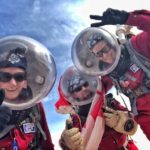
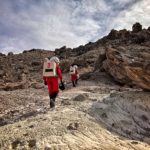
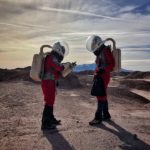
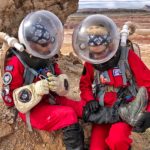
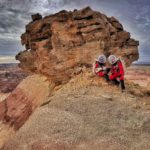

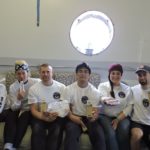
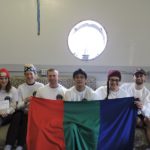
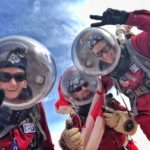
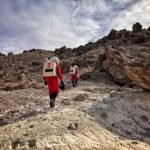
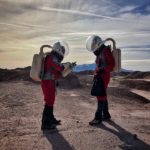
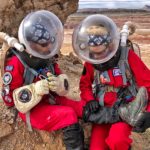
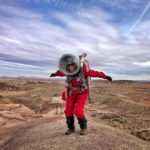

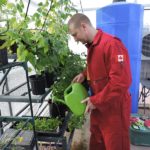
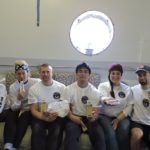
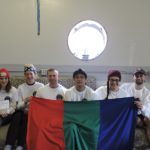
You must be logged in to post a comment.